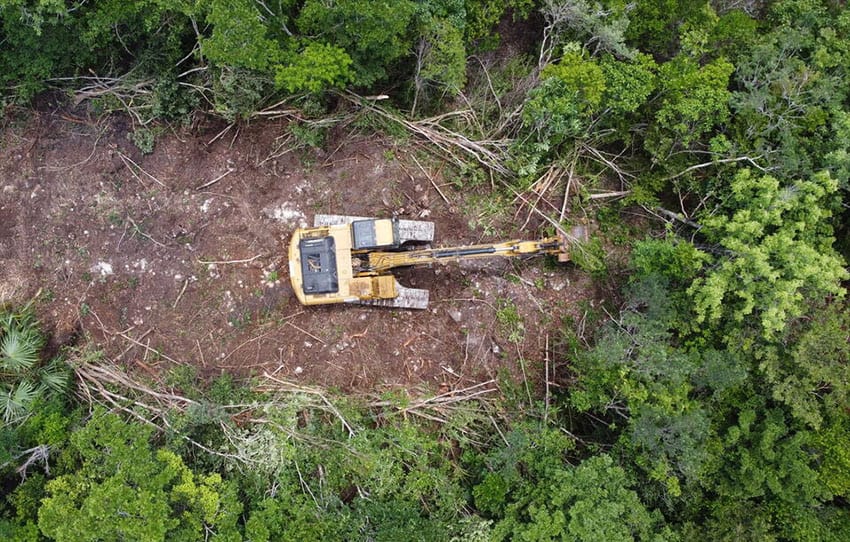With ramifications that ripple through the entire country and across the world, one story that has come out of Mexico in the past years has gripped the global media: the Maya Train. One of the most expensive and ambitious infrastructure projects in Mexican history, the biodiesel-powered tourist and freight train has begun to snake its way around the Yucatán peninsula, connecting locations in Tabasco, Campeche, Yucatán, Quintana Roo and Chiapas, allowing people to visit the ancient archaeological sites, colonial cities and cenotes of southeastern Mexico.
Arguably the public works piece de resistance of Andrés Manuel López Obrador’s presidency, the president, a Tabasco native, has maintained his line on the project since construction began in 2019: “Both the construction and operation of the Maya Train railroad will help generate economic prosperity and well-being in the five states through which it runs.”

Documentarians set out to record the Maya Train and the environmental damage
Might the Maya Train be ruining the lands of the modern Maya? This is the argument of “El Tren y La Peninsula,” a 2023 documentary that depicts the dispossession of the descendants of the peninsula’s ancient civilizations. The documentary is available free on Mirada Natava and will debut on Mexico’s Canal 11 this summer.
“We set out to investigate the unknowns of this mega project, in the midst of the pandemic and ended up with what is now being called a historical document,” explains Sky Richards, who co-directed the film with Andreas Kruger. “Our agenda was to have no agenda, to be truly transparent with what we experienced.”
Their ode to nature and the Maya legacy, is a beautifully shot and intimate portrait of a way of life. But it omits what Richards says he observed: people who have little autonomy or land rights, displaced between ancient and modern forms of development. Sky found a people confronted with a generational curiosity for globalization, caught between the perks of its trajectory replacing their way of life. He continued, “Most of the images in the film no longer resemble the current landscape. The train’s construction has changed everything for miles around the track, basically overnight.”
Revolution and collapse
This area will not let us forget that social injustice leads to upheaval. The late 19th/early 20th century Caste War of Yucatán was a precursor to the Mexican Revolution — an uprising famously fought on trains. The Caste war is now known as the Maya Uprising, according to documentarian Richards and in this fight too, the peasantry resorted to using trains to combat other trains.
But misery was definitively visited upon the modern Maya by another maritime disruption; World War II. The industrial pressures put on tire production which required rubber trees, parachutes made of silk and marine ropes made out of natural fibers from Mexico, forced the invention of cheaper synthetic fibers. Nylon gave the coup de grâce to the thriving monopoly on fibers produced in the Yucatan. These fibers were traditionally manufactured from a prehistoric looking cousin of maguey and agave, henequen, which was transported from the plantations to the ports by the original railway systems of the area.
The Yucatán Peninsula is one of the most impoverished areas in the Americas. The scarce job opportunities available are for the most part menial jobs in the coastal tourist industry, and the Maya have all but abandoned their crafts and agriculture since they have ceased to be financially viable. For survival, they have sold off their land for pennies and have walked right into the factories on Mexico’s northern border.
The peninsula’s hidden Maya cities themselves may also represent an environmental cautionary tale. One of the most solid theses that attempt to explain the mysterious decline of the Classic Maya civilization points precisely to a man-made ecological catastrophe: the over-exploitation of natural resources to feed the golden age of Maya civilization.
Will the Maya Train offer salvation for Indigenous communities?
Could the train offer access to more viable and dignified local employment? The United Nations Human Settlements Program projects the positive figures of one million more jobs by 2030 and double the economic growth in local townships where the train passes through by that year — which could far surpass the economic growth of the industrial north. In late 2022, the National Tourism Fund (Fonatur) reported that the train had already created more than 140,000 jobs in southeastern Mexico — making it the top job creator in the region — and could create another 715,000 by 2030.
Previously inaccessible treasures of Maya culture will become a viable adventure for national and international travelers, who thus far could only dream of these sacred cities, depicted by only the most daring explorers. The National Institute of Anthropology and History (INAH) now has not only the means but the incentive to better protect and further explore the ancient Maya world, and has constructed new museums to house the treasures unearthed during development.
Might the resurrection of this railway be a harbinger of prosperity for the region’s Indigenous peoples, who could recover their traditional arts, crafts and world-famous cuisine by catering to new patrons? That could keep the locals from having to sell their lands and migrate north. Agriculture would be re-established, requiring clean sources of water, which might, in turn, cause pressure to mobilize political mechanisms of equitable and sustainable regulations.
In the grand scale of things, throughout ecological apocalypse and social upheaval, Maya peoples have fiercely defended their way of life and their surroundings. The political vitality of Mexico and the world’s increasing fascination with the Yucatán Peninsula and the Maya Train may prove auspicious for the peninsula’s Indigenous peoples yet.
Henrietta Weekes is a writer, editor, actor and narrator. She divides her time between San Miguel de Allende, New York and Oxford, UK.
